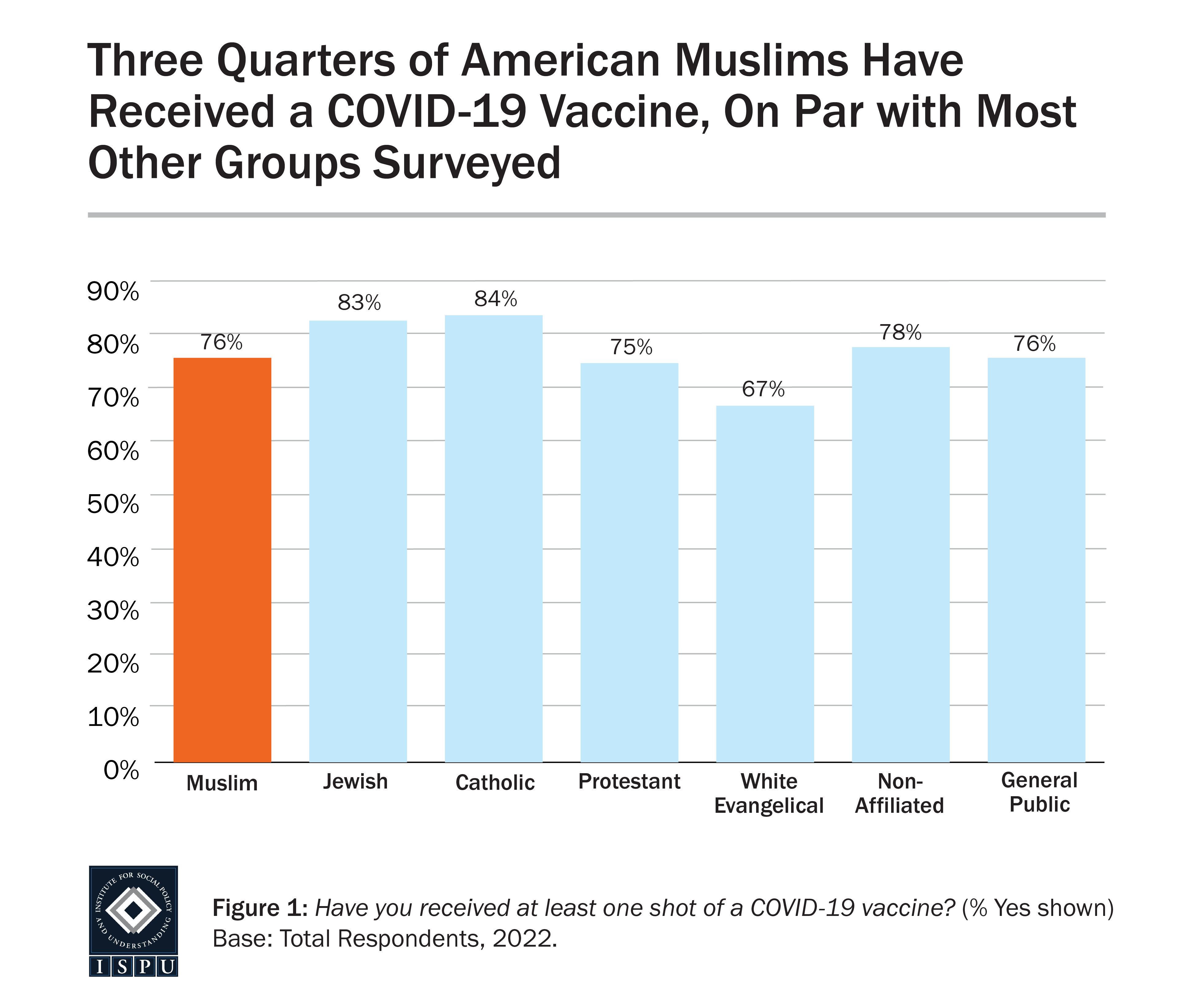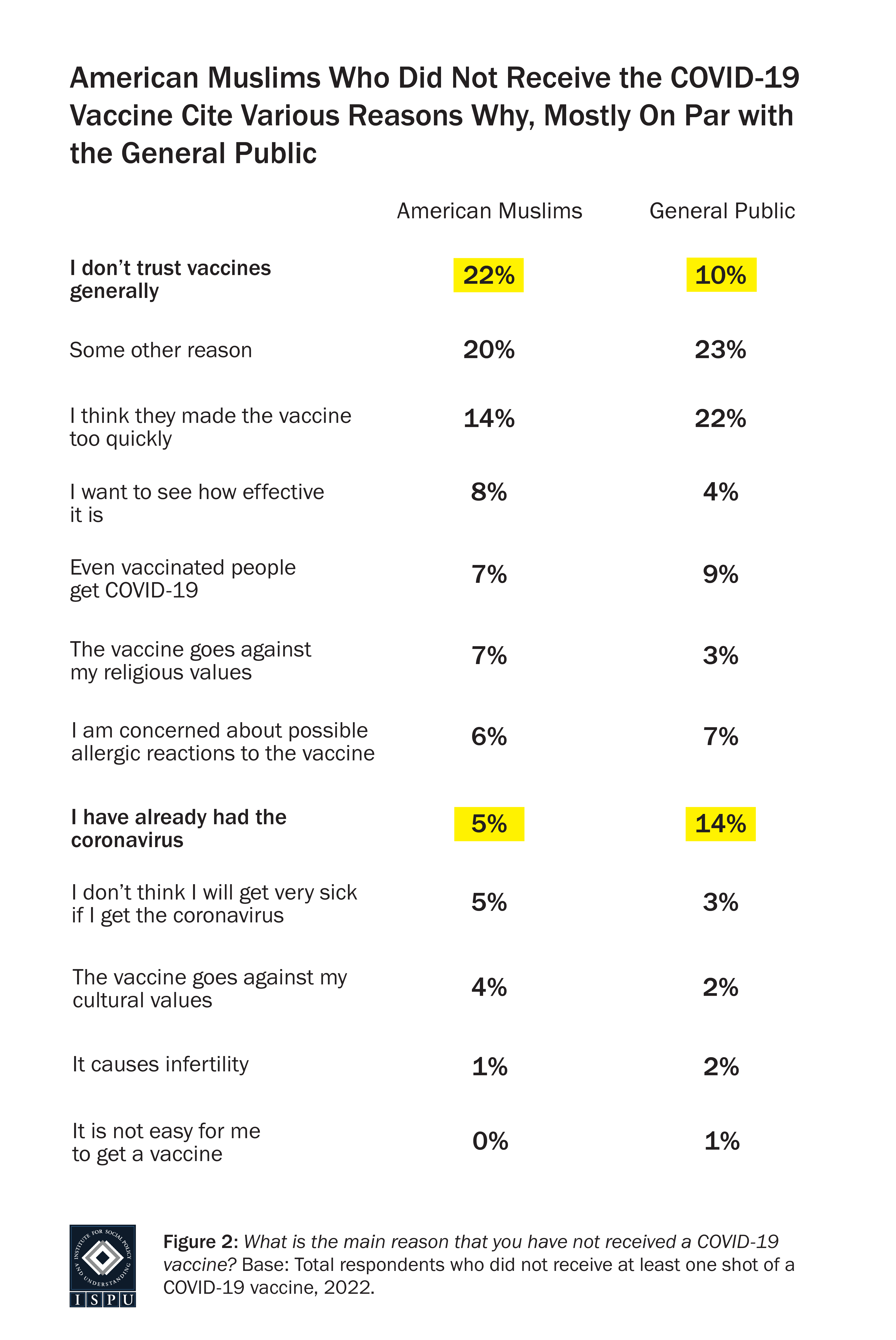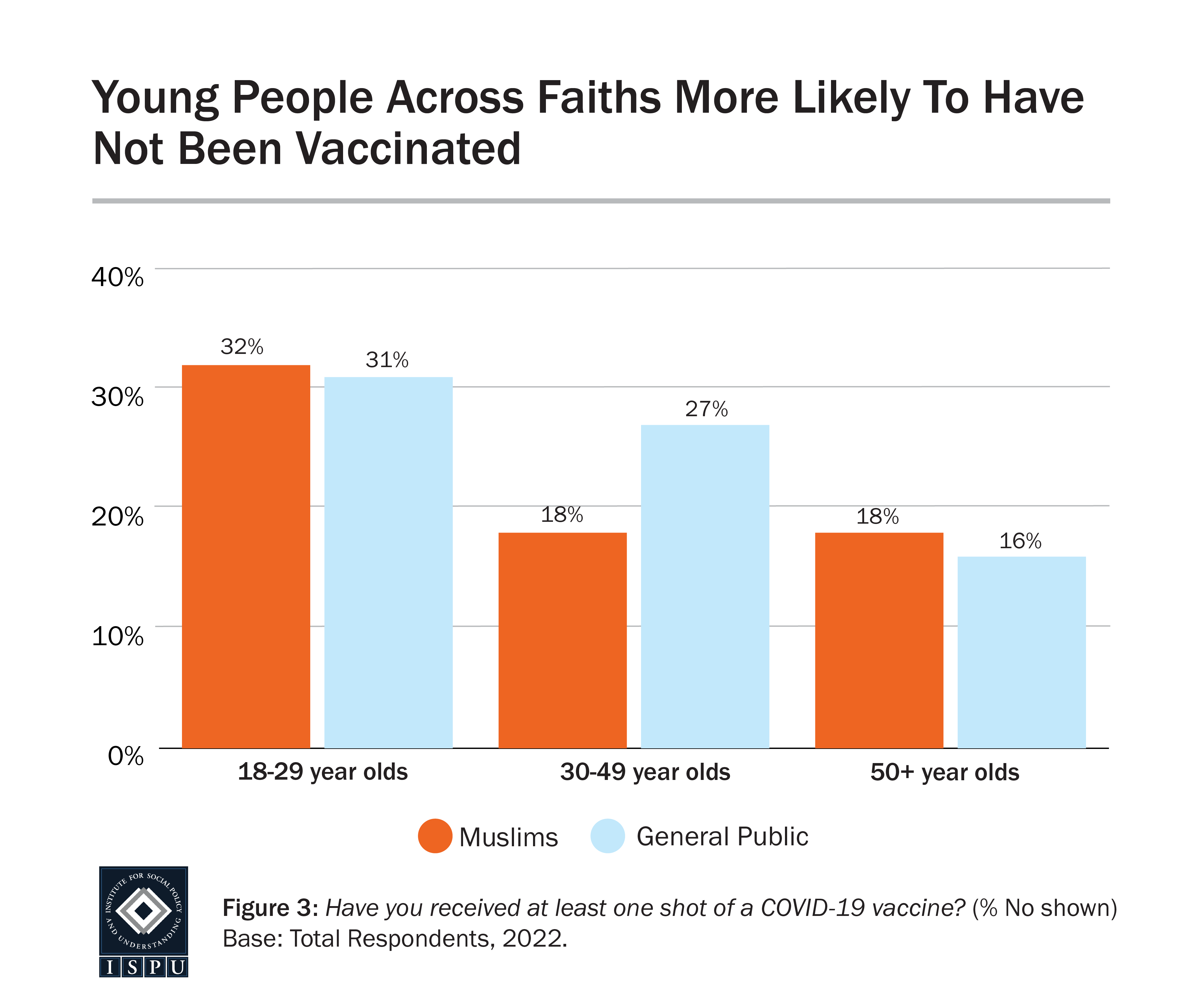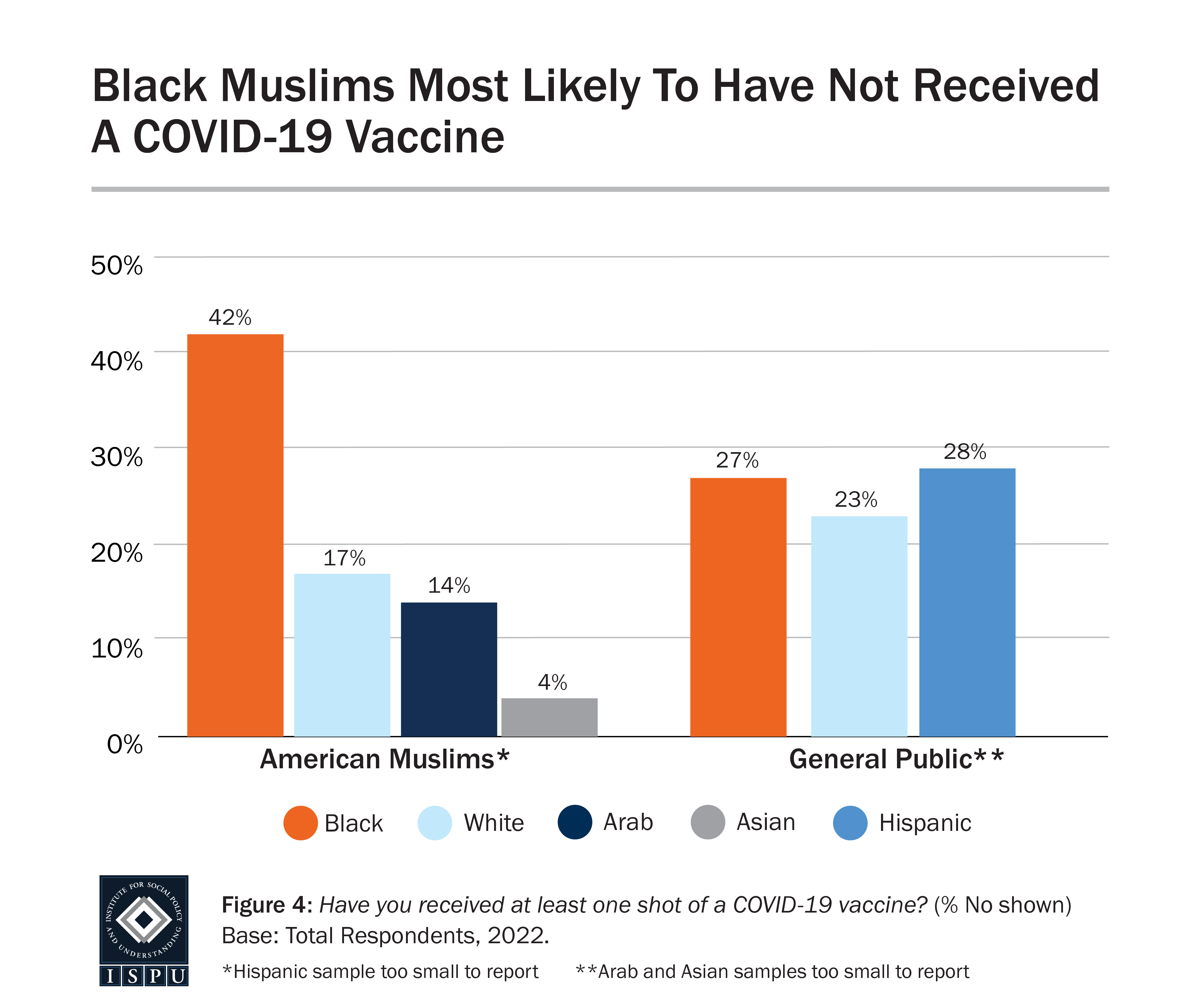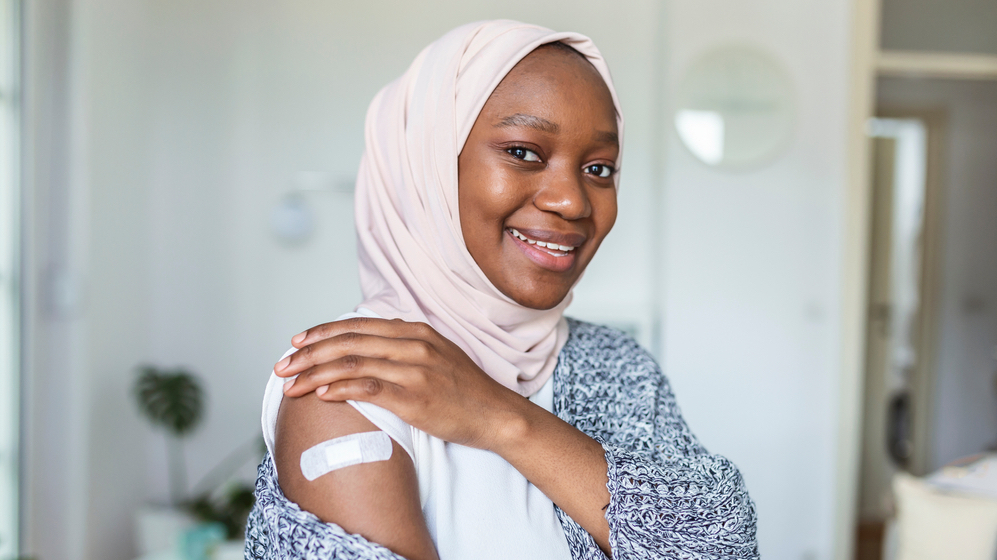
Black Muslims and Younger Muslims Least Likely to Be Vaccinated
Most common reason for vaccine hesitancy is lack of trust of vaccines overall
April 18, 2022 | BY ERUM IKRAMULLAH
As of Spring 2022, many Americans find themselves in a “new normal.” But the “new normal” may look different for everyone depending on their own personal circumstances and risk assessment. While mask mandates and social distancing have mostly ceased, COVID-19 vaccine uptake remains a key public health goal and metric. As of April 7, 2022, the CDC reports 88% of American adults have received at least one shot of the COVID-19 vaccine. While this metric represents tremendous progress since the vaccines first became available in 2021, more information is needed to identify groups of Americans who may remain vaccine hesitant and their concerns. Tailored outreach based on information and understanding can help improve vaccination campaigns.
The Institute for Social Policy and Understanding seeks to provide this data, which does not exist anywhere else, for the American Muslim community through its American Muslim Poll. Now in its sixth year, American Muslim Poll captures a snapshot of American Muslim experiences in all their diversity, as well as tracking trends over time. The survey not only polls Americans who are Muslim, but Americans of other faiths and no faith as well. This allows readers to understand American Muslims’ perspective within the context of their nation’s faith landscape, not as an isolated specimen.
MORE ANALYSES
Substance Abuse and Addiction in the Muslim Community
The (Dis)parity of White Muslim Political Attitudes
American Muslim Policy Priorities
Five Surprising Facts about Divorce in American Muslim Communities
Not Immune: Some Muslims in America Internalize Islamophobia
Unwanted Sexual Advances from Faith Leaders Are Equally Prevalent Across Faith Groups
Muslims Profess More Private Religious Devotion, Less Public Religious Assertiveness

Black Muslims and Younger Muslims Least Likely to Be Vaccinated
Most common reason for vaccine hesitancy is lack of trust of vaccines overall
April 18, 2022 | BY ERUM IKRAMULLAH
As of Spring 2022, many Americans find themselves in a “new normal.” But the “new normal” may look different for everyone depending on their own personal circumstances and risk assessment. While mask mandates and social distancing have mostly ceased, COVID-19 vaccine uptake remains a key public health goal and metric. As of April 7, 2022, the CDC reports 88% of American adults have received at least one shot of the COVID-19 vaccine. While this metric represents tremendous progress since the vaccines first became available in 2021, more information is needed to identify groups of Americans who may remain vaccine hesitant and their concerns. Tailored outreach based on information and understanding can help improve vaccination campaigns.
The Institute for Social Policy and Understanding seeks to provide this data, which does not exist anywhere else, for the American Muslim community through its American Muslim Poll. Now in its sixth year, American Muslim Poll captures a snapshot of American Muslim experiences in all their diversity, as well as tracking trends over time. The survey not only polls Americans who are Muslim, but Americans of other faiths and no faith as well. This allows readers to understand American Muslims’ perspective within the context of their nation’s faith landscape, not as an isolated specimen.
American Muslims are on par with the general public, as well as most other faith and non-faith groups surveyed, in uptake of the COVID-19 vaccine
-
- As of March 2022, 3 out of 4 American Muslims (76%) have received at least one shot of the COVID-19 vaccine, on par with the general public (76%), Jewish Americans (83%), Catholics (84%), Protestants (75%), and the non-affiliated (78%).
- About two-thirds of white Evangelicals (67%) received a shot of the COVID-19 vaccine, less likely than all other groups surveyed.
- American Muslim men and women are similar in their uptake of the COVID-19 vaccine.
Among Muslims, 18-29 year olds and Black Muslims are least likely age and racial groups to have received a shot of the COVID-19 vaccine, while Asian Muslims are most likely
-
- Among Muslims and the general public, about one third of 18-29 year olds have not received a COVID-19 shot (32% among American Muslims and 31% among the general public). Far fewer of those 50 or more years old have not received a vaccine shot (18% of American Muslims and 16% of the general public). When looking at 30-49 year olds, we find Muslims are less likely to have avoided taking the vaccine than their generational peers in the general public. Specifically, 18% of 30-49 year old Muslims have not received a vaccine shot, on par with the oldest Muslims but much less likely than the 27% of 30-49 year olds in the general public who have not received a shot.
- When looking at vaccine uptake by race, we find that almost half (42%) of Black Muslims did not receive a shot of the COVID-19 vaccine, compared with 17% of white Muslims, 4% of Asian Muslims, and 14% of Arab Muslims. Black, white and Hispanic members of the general public are equally likely as each other to have not received a vaccine shot (27%, 23%, and 29%, respectively). Black Muslims (42%) are more likely than Black Americans in the general public (27%) to have not received a COVID-19 vaccine.
- A quarter of both young Muslims aged 18-29 (29%) and Black Muslims (25%) who did not receive a vaccine shot cite “I don’t trust vaccines generally” as the reason for their vaccine hesitancy. Almost one-third of Black Muslims (31%) who have not received a vaccine cite “some other reason” for their hesitancy.
About 1 in 5 Muslims who did not receive the COVID-19 vaccine reported a general distrust of vaccines as the reason
-
- Among those who did not receive the COVID-19 vaccine, American Muslims were more likely than the general public to cite a general distrust of vaccines as the reason (22% vs. 10%).
- Other top reasons for vaccine hesitation cited by American Muslims include: “I think they made the vaccine too quickly” (14%) and “some other reason not listed” (20%), both of which were also cited by at least 1 in 5 people in the general public (22% and 23%, respectively).
- American Muslims who did not receive the COVID-19 vaccine were less likely than those in the general public who did not receive the vaccine to report “I have already had the coronavirus” as the reason for their vaccine hesitancy (5% of Muslims vs. 14% of the general public).
- Smaller proportions of American Muslims who did not receive the COVID-19 vaccine cite other reasons for vaccine hesitancy on par with the general public, including reasons like “the vaccine goes against my religious values” and “the vaccine goes against my cultural values” (7% and 4%, respectively).
Recommended uses of this data:
-
- Public health officials and community leaders can use this data to identify key demographics in the Muslim community for outreach and education about COVID-19 vaccines.
- The data also provide insight into reasons for hesitancy, allowing leaders to approach outreach from a place of understanding and sensitivity to concerns.
- Public health officials and Muslim community leaders can use this data to advocate for Muslim community needs through local health departments and clinics.
- When considering outreach to the Black Muslim community regarding vaccine uptake, it is critically important to first step back and learn about the historic and current systems of medical racism. Black Muslims carry intersecting group identities that face racism, discrimination, and surveillance, broadly, and within healthcare. Outreach should be conducted with this context in mind by a trusted messenger from within the community.
- This Ramadan, Eid, and beyond, when Muslims will likely gather more than they have in the past two years, community leaders have an opportunity to provide sensitive outreach around vaccine uptake, particularly during youth-focused events/gatherings.

Erum Ikramullah is a Research Project Manager at ISPU, where she manages the day-to-day activities of the organization’s research studies. Learn more about Erum→


